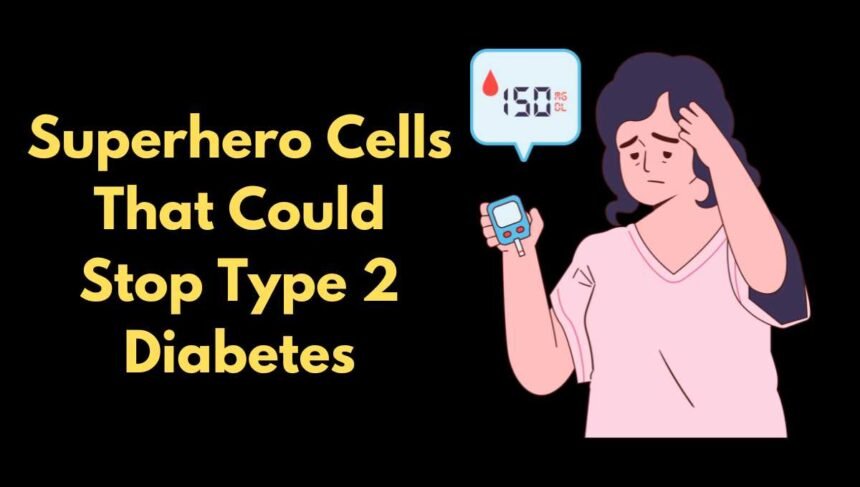Changes in lifestyle, such as diet, exercise, and weight management, have been used for a long time for type 2 diabetes prevention.
Even though these are still very important, new, ground-breaking study points to something even stronger: “superhero” beta cells in the pancreas called cluster 1 cells.
These special cells that make insulin might be the key to stopping type 2 diabetes at the cellular level, especially in people who are at a high risk because they are overweight, have a family history of it, or are older.
We’ll talk about how new scientific findings, especially the discovery of these powerful beta cells, are changing how we think about preventing type 2 diabetes in this post.
We’ll also talk about how lifestyle choices and new treatments may one day help protect or repair these “superhero cells” before diabetes starts.
The Pancreas and Its Unsung Heroes: Beta Cells
With the help of insulin, the pancreas is a small but powerful organ that keeps blood sugar levels in check.
Beta cells, which are specific cells found in the islets of Langerhans, make this hormone. As a key, insulin lets glucose (sugar) into the cells of the body so that it can be used as energy.
But not every beta cell is the same.
Researchers at Weill Cornell Medicine did a new study that was published in Nature Cell Biology.
They found that beta cells come in at least four different subtypes. One group of beta cells, called “cluster 1,” stood out because it was better at making insulin and keeping blood sugar in check.
These cells have a special protein on the outside called CD63 that helps us find and separate them.
Lead researcher Dr. James Lo says that cluster 1 cells have a faster metabolism, react faster to rising glucose levels, and may offer strong resistance to blood sugar spikes. This makes them very important in the fight against type 2 diabetes.
The Missing Link in Type 2 Diabetes Prevention?
The team from Weill Cornell made an important discovery: in obese and diabetic mice, the number of cluster 1 beta cells was greatly reduced or missing.
The animals couldn’t control their blood sugar without these specific cells, even when other beta cells were present.
To see if these cells could help avoid diabetes, researchers gave diabetic mice extra cluster 1 beta cells. As a result?
In contrast to mice that got standard beta cells, their blood sugar levels returned to normal very quickly.
This means that keeping or improving cluster 1 cells in people who are at risk could delay or even stop the start of type 2 diabetes.
One of the most exciting things about this finding is that it could lead to early diagnostic tools.
Scientists may soon be able to use the CD63 protein to figure out how healthy and how many of these important cells people have because cluster 1 cells have it on their surface.
People who are overweight, in the early stages of diabetes, or who have a family history of diabetes can now get a preventative test.
If it turns out that a patient doesn’t have enough cluster 1 cells, focused treatments could start right away, before type 2 diabetes gets worse.
Lifestyle Interventions That May Protect Beta Cells
Studies have shown for a long time that food and exercise have a direct effect on the health of beta cells.
1. Choices about food
A study called the Diabetes Prevention Program (DPP) found that adults who are at high risk of getting type 2 diabetes can cut their chance by up to 58% by losing 5 to 7 percent of their body weight through diet and exercise.
Blueberries, leafy veggies, and whole grains are some foods that are high in antioxidants. These foods may help lower inflammation and oxidative stress on beta cells.
A study published in Nutrients in 2022 also showed that vitamin D may help protect pancreatic function. It makes insulin work better and may help keep beta cell mass.
2. Work out
It has been shown that both aerobic and resistance training can improve insulin sensitivity and lower fat around the pancreas.
These two effects are good for beta cell health. The American Diabetes Association says that getting at least 150 minutes of mild exercise a week greatly lowers the chance of getting type 2 diabetes.
Pharmaceutical Approaches: Can We Protect or Regrow Cluster 1 Cells?
Lifestyle changes are fun, but they might not be enough for everyone, especially people who are more likely to be overweight because of their genes. That’s where new ideas in pharmaceuticals come in.
As of right now, Dr. Lo’s team is looking into whether GLP-1 receptor agonists (like Ozempic and Trulicity) help or hurt cluster 1 cells.
Early research shows that these drugs not only make insulin work better, but they also help beta cells grow back.
Stem cell treatments are also being looked into as a way to grow new beta cells in the lab, including the hard-to-find cluster 1 subtype.
If these lab-grown cells work, they could be transferred into people who are at risk for getting diabetes to stop it from happening.
A lot of people with type 2 diabetes get it from their parents. Your risk goes up a lot if your parents or brothers have the condition.
Scientists are now looking into how genes affect the number of cluster 1 beta cells and how they work.
Epigenetic modifications, which are changes in gene expression caused by behavior or the environment, may also play a part.
For instance, long-term stress or inflammation can change the way genes work in beta cells, which can make them less useful or even kill them.
In the future, medicines may be able to target these epigenetic changes to help cluster 1 cells live longer before diabetes starts.
The Future of Type 2 Diabetes Prevention Is Personalized
With discoveries like cluster 1 beta cells and the CD63 biomarker, we are moving toward a personalized prevention model. Rather than a one-size-fits-all approach, future diabetes care may include:
- Cellular screening for cluster 1 beta cell presence
- Tailored nutrition and supplement plans to support beta cell health
- Preventive medications targeting cellular pathways
- Regenerative therapies to replace lost cells
This shift could transform how we think about type 2 diabetes not as an inevitable outcome for high-risk individuals, but as a preventable condition rooted in cellular biology.
Finding cluster 1 beta cells was a big step forward in our understanding of how to stop type 2 diabetes.
Some people with similar habits may not get diabetes while others do. These powerful insulin producers may be the missing link.
Even though more study is needed, cutting-edge science and making changes to our lifestyles give us real hope.
We might be able to stop type 2 diabetes before it starts if we work hard to protect beta cells, especially the cluster 1 cells that look like superheroes.
Disclaimer
The information provided in this blog post is for educational and informational purposes only and is not intended as medical advice. Always consult with a qualified healthcare professional before making changes to your diet, medication, or health regimen, especially if you have or are at risk for type 2 diabetes. The content is based on current research available at the time of writing and may evolve with new scientific findings.












